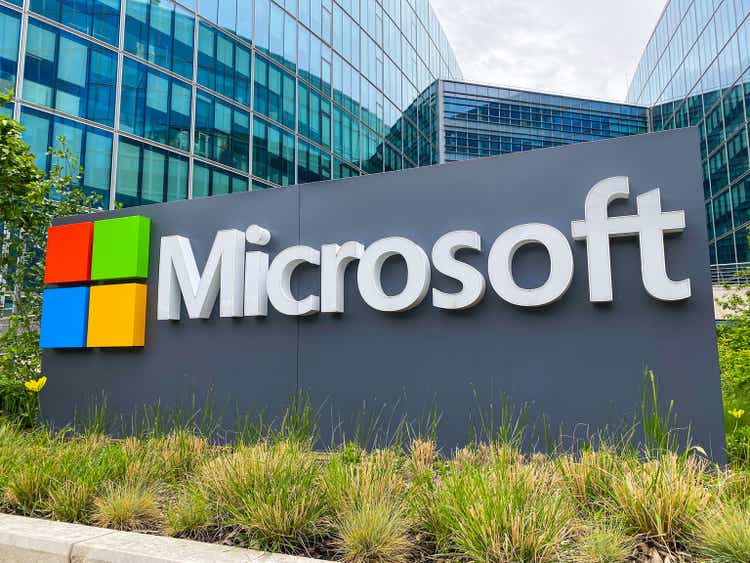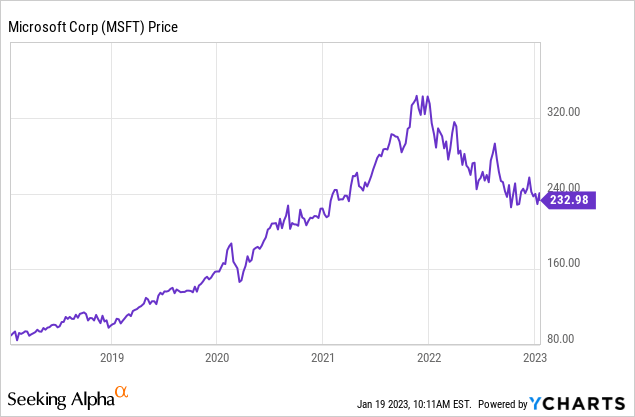Summary:
- Microsoft has followed fellow tech giants by announcing layoffs of 10,000 employees around the world and taking a $1.2 billion restructuring write-off.
- There’s nothing fundamentally wrong with Microsoft’s business, however. The company will be able to use payroll savings to fund a potentially game-changing investment in OpenAI.
- The main bull and bear case for MSFT, and a look at valuation and the ATVI deal.
- When to purchase MSFT stock, depending on your risk tolerance, plus a bonus merger-arb trade in ATVI.
Jean-Luc Ichard
Microsoft’s (NASDAQ:MSFT) stock was one of the biggest winners from the pandemic, with the stock surging over 100% in value from early 2020 to its peak in late 2021. Microsoft hired aggressively during this time, taking its employee count from around 163,000 employees in 2020 to over 221,000 at the last count. Now, with earnings slowing down compared with the peak, Microsoft has announced layoffs of roughly 10,000 employees. This follows similar moves by big-tech peers Amazon (AMZN) and Google (GOOG). MSFT stock is now down about 33% from the peak. So does this mean the business is struggling? Not necessarily. Microsoft is one of the most successful stocks of all time- I’ve covered Microsoft before as a cash cow blue chip, and I see no reason that the long-term thesis isn’t still intact. MSFT stock may not have bottomed yet due to being tied to the broader macro environment, but I’ll cover entry points based on your risk tolerance below.

Microsoft: Bull and Bear Case
Microsoft’s chart is scary here – the stock has basically been a one-way money train over the last 10 years and now that trend is broken. The current drawdown is about twice as severe as the worst drawdown over the last 10 years, harkening back to the bad old days of post-2000 Microsoft when the stock completely deflated in the aftermath of the tech bubble. But MSFT is where it is today because it has reinvented itself from simply being the company that made Windows and MS Office – the one-way train over the last 10 years has been driven in large part by its Azure cloud computing business, which is going to keep growing. Windows and MS Office didn’t go away, but new growth came from the cloud to massively increase the value of the company. Now, as I’m sure many of you know, Microsoft is preparing a $10 billion investment in OpenAI, the creator of bombshell artificial intelligence chatbot ChatGPT.
It’s hard to fault MSFT here for cutting back after hiring so aggressively- if they’re saving $150,000 per year in salary, benefits, and office rent for each highly compensated tech employee they lay off, that’s $1.5 billion annually. In fewer than seven years, that completely pays for the potentially game-changing investment in AI. That’s the bull case, obviously, leading some analysts to compare MSFT’s investment in OpenAI to the invention of the iPhone. Like other tech companies, Microsoft should be able to further reduce its headcount through natural attrition – keeping the headcount in line with the profitability of the business and repositioning the company as needed.
The bear case here is pretty simple, but it’s less potent than it was in early 2022. In short, valuation. MSFT trades for approximately 25x forward earnings, while at its peak in late 2021, it traded for about 36x. MSFT is a massive company, and the amount of annual earnings that are required to justify a 36x forward valuation on a company that was worth over $2 trillion makes it very hard in practical terms to earn the kind of returns MSFT shareholders were used to. MSFT’s cloud computing business is a runaway success story, but consider that a lot of forecasted tech over the past few years hasn’t gotten any traction – including the metaverse, blockchain finance, and self-driving cars.
- The metaverse has always been and always will be a weird idea.
- Blockchain finance has some limited uses, but judging by Justice Department and SEC press releases, one of the main uses seems to have been fraud.
- And self-driving cars are still a long way from viability.
Chat GPT feels different – when you try it, it’s hard to deny the magic. But monetizing the AI is no immediate slam dunk, which is why you wouldn’t want to pay 100x earnings (or subsidize losses) for a company just because it has AI in the name. Therefore, smart investors consider not only the upside potential of any given tech or business but also the valuation that they’re paying to see if they’re getting enough compensation for risking their capital. As far as Microsoft is concerned, they’re not struggling. Earnings are near all-time highs, and they haven’t sunk money into any strategic blunders as some of their competitors have. As such, MSFT has an above-market valuation, but one that I believe is justified in the long run.
MSFT: Current Valuation
Having taken a look at the bull and bear cases for MSFT, is the current valuation sufficiently compensating you for buying the stock?
If you take the inverse of 25x, you’re getting a 4% earnings yield for buying into MSFT. This isn’t bad for a stock with MSFT’s past and present growth potential. Granted, they’re not paying all of this out as a dividend (MSFT yields about 1.2%), but rather using most of the money to buy back shares and reinvest in the business. MSFT is largely a royalty business outside of the cloud, which is why its gross margins are so good. What does this mean for you as an investor? High gross margins and monopoly power over parts of its business mean that MSFT’s earnings have a high floor over the next decade compared with other tech companies. This means that while MSFT is just as volatile as other stocks in the short run, you’re not taking as much long-term risk by investing in MSFT compared with other stocks.
Of course, MSFT’s growth also depends on Azure, as well as the ongoing acquisition effort of Activision Blizzard (ATVI).
As of last quarter, Azure continues to grow at 35% annually, which freaked trigger-happy Wall Street traders out because it slowed from 50% per year. These are all still huge numbers. You put it all together, and the consensus from analysts is that MSFT will grow earnings from $9.50 per share to $13 by 2025. We shouldn’t always blindly trust the wisdom of the crowd, but for Apple (AAPL) for example, analysts expect single-digit earnings growth. For MSFT, the ceiling is much higher. Combining Chat GPT with Azure is another potential driver here, and could give Microsoft a sustained advantage to get a leg up over Amazon AWS as well.
As for the ATVI acquisition, The US FTC is challenging the deal, with the EU expected to follow. It’s silly and political, though – why not focus FTC attention on going after genuinely destructive monopolies like the American slaughterhouse monopoly, or shutting down price-fixing software for landlords? Americans now live six years fewer than their European peers, so if I were a regulator, I’d be focusing my attention on the quality of life issues rather than whether Microsoft can vertically integrate Call of Duty with Xbox! MSFT is fine without this deal, but if it goes through, it should be a nice growth driver. For a bonus trade here, all you have to do is buy ATVI and wait. Since MSFT is paying $95 if the deal closes and ATVI is trading for $74, you stand to make $21 if the deal goes through. While you wait, you’ll also get a dividend, albeit a modest one. It sounds simplistic, but Warren Buffett and Berkshire Hathaway (BRK.B) currently own $4.5 billion of ATVI stock for this very reason. The obvious downside to mergers taking a long time is that your money is tied up, but the upside is that as an individual investor, you don’t have to pay short-term capital gains tax on your profit if you hold over a year.
Put these together, and the combination of a higher floor and higher ceiling for MSFT vs. other mega-cap tech stocks makes MSFT a good long-term bet. Prospective MSFT shareholders should be able to earn above-market returns going forward by taking advantage of the fall in share price. By contrast, mega-cap peer Apple is likely to see below-market returns due to its lower floor and ceiling for earnings growth. ATVI is interesting as well, for those interested.
Has MSFT Bottomed?
MSFT’s valuation is down one-third since late 2021 but is still higher than the market’s valuation as a whole. Even without a lot of growth, you’ll eventually make your money back by investing in MSFT stock, but to earn positive returns over any reasonable time period, you’ll need growth. This is difficult to figure out because Microsoft clearly has some long-term drivers of growth, but is seeing a short-term cyclical slowdown. Normalized earnings for MSFT have grown for 10 years straight (ignoring one-time adjustments like the Trump tax cuts). Now they’re coming down a bit after booming during COVID.
Due to the macro factors in play, I don’t believe MSFT has quite yet bottomed. As one of the largest companies in the broader stock market, MSFT is tied to index fund/ETF money, which is tied to liquidity. However, long-term and risk-tolerant investors can start buying the stock now and accumulate more if the stock continues to sink. More conservative investors could buy in around $190-$200. That would be around 20x earnings for MSFT and would represent a nice GARP opportunity with a higher floor than buying now.
However, the current price is reasonable for a growth stock and offers long-term upside and reasonable long-term cushion on the downside. By virtue of its earnings yield and growth prospects, MSFT currently offers low-double-digit annual prospective returns for investors. Buying the stock now is fine, and buying under $200 should be even better. With the acquisition pending, ATVI is another stock worth looking at, and a trade I find a bit more attractive while waiting for MSFT to come down in price.
Disclosure: I/we have a beneficial long position in the shares of ATVI either through stock ownership, options, or other derivatives. I wrote this article myself, and it expresses my own opinions. I am not receiving compensation for it (other than from Seeking Alpha). I have no business relationship with any company whose stock is mentioned in this article.
